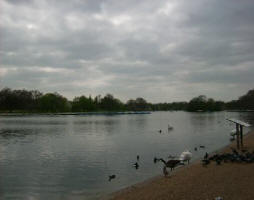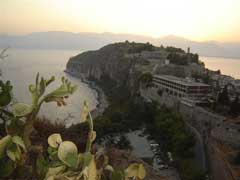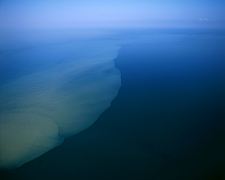 Using small devices to desalinate water
Using small devices to desalinate water
Various attempts have been made to make small devices which can convert
salt water into safe drinking water - something that could be a boon to
people in remote areas with abundant salt water sources but no potable
water.
Clear Water Solutions, a Swiss-based company, has
developed a very simple method to desalinate and purify water. The
device is made from solar cell plates and can produce up to 12-18
litres of fresh drinking water from about 40 litres of sea or salt
water per day. The water is heated in the cell by the sun; a part of it
evaporates, rises up and condenses on the cooler glass cover. Water
then flows along the glass and over a separate channel into the distilled-water collector.
Another desalination device using solar power was developed by the
Research Institute for Sustainable Energy based in Murdoch, Western
Australia. The solar energy evaporates the sea water inside a glass
covered box, condensing the humidity on the lower side of the glass
cover. Desalinated water droplets condense on the internal side of the
cover and are channelled in to a collector.
Water cone
MAGE Water Management, a German-based company, has come up with the
idea of a simple and easy to transport desalination device, called water cone.
Mirco Richardson of MAGE said: “The principle is very simple: You have
a base pan, which will take up to 3-5 litres of sea water; you pour
that water into the pan, then you float the cone on top of the pan
thereby creating a closed circuit system inside, which means you seal
the whole system. You let the sun shine onto the cone and within
minutes you have a certain evaporation-condensation process that takes
place.”
Access to the drinking water is achieved by removing the cone from the
pan and pouring it into a bottle. Between 1.4 and 1.6 litres of clean
drinking water can be harvested in 24 hours, according to Richardson.
This may not seem a lot, “but when you compare it to… no water, then
1.5 litres of drinking water is a whole lot for every day,” he said.
Average daily water consumption for children and adults ranges between one and three litres, according to a World Health Organization (WHO) report.
Mark Silbernagel, test director at the Seawater Desalination Test
Facility in Port Hueneme in California and a member of the technical
advisory committee for the US-based Global Water NGO, said that while
the design would definitely work to produce small quantities of potable
water the amount of water produced might not be enough.
“The drawback is that 1 to 1.7 litres of water in a 24-hour period is a
very small quantity of water for a person in arid regions. It would
take multiple water cones to satisfy the needs of a single person,”
Silbernagel said.
Germs
Meanwhile, Roya Sheikholeslami, chair of Chemical Process Engineering
at the University of Edinburgh, told IRIN that the issue was: “How does
one prevent biological growth in such a system? That would be a major
health challenge.”
Richardson said “because you have UV radiation, it kills a lot of germs
and bacteria that can possibly develop in there”. He added that the
water cone also acted as a filter. “You can filter with this. If you
have mercury or arsenic in the base water, we can filter that out too
through evaporation-condensation.”
According to the Encyclopedia of Desalination and Water Resources (DESWARE),
the quality of harvested water is very high because all the salts,
inorganic and organic components and microbes remain in the base water.
In sunny conditions the temperature of the water rises sufficiently to
kill all pathogenic bacteria.
“There are many other
systems that filter, but most filtering systems do not desalinate, so
this is our little niche,” said Richardson.
Cost-effective?
The water cone system costs about 20 euros (about US$26.5) - down from 100 euros when it was first produced 6-7 years ago.
“By investing 20 euros you can have 1.5 litres of clean drinking water
a day for 1.5-2 years,” Richardson said. Provided the cone is used for
two years, the monthly cost is about $1.10.
During a project in Yemen in 2004, he said, fishermen took the water
cones with them on fishing expeditions, allowing them to spend longer
at sea and catch more fish.
However, Silbernagel said that the cost of 20 euros was high. “I would
have expected something like this to be less than 10 euros. The water
cone has the potential to be very inexpensive,” he said.
| Contact information | n/a |
|---|---|
| News type | Inbrief |
| File link |
http://www.irinnews.org/Report.aspx?ReportId=84329 |
| Source of information | Irin News - © IRIN 2009. |
| Keyword(s) | desalination |
| Subject(s) | ANALYSIS AND TESTS , CHARACTERISTICAL PARAMETERS OF WATERS AND SLUDGES , DRINKING WATER , DRINKING WATER AND SANITATION : COMMON PROCESSES OF PURIFICATION AND TREATMENT , ENERGY , INDUSTRY , INFRASTRUCTURES , POLICY-WATER POLICY AND WATER MANAGEMENT , SANITATION -STRICT PURIFICATION PROCESSES |
| Relation | http://www.semide.net/topics/Desalination |
| Geographical coverage | United Arab Emirates |
| News date | 11/05/2009 |
| Working language(s) | ENGLISH |
 you are not logged in
you are not logged in





